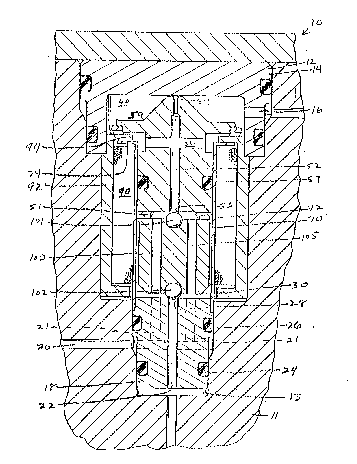Some of the information on this Web page has been provided by external sources. The Government of Canada is not responsible for the accuracy, reliability or currency of the information supplied by external sources. Users wishing to rely upon this information should consult directly with the source of the information. Content provided by external sources is not subject to official languages, privacy and accessibility requirements.
Any discrepancies in the text and image of the Claims and Abstract are due to differing posting times. Text of the Claims and Abstract are posted:
| (12) Patent Application: | (11) CA 2016421 |
|---|---|
| (54) English Title: | SOLENOID VALVE |
| (54) French Title: | VANNE ELECTROMAGNETIQUE |
| Status: | Deemed Abandoned and Beyond the Period of Reinstatement - Pending Response to Notice of Disregarded Communication |
| (51) International Patent Classification (IPC): |
|
|---|---|
| (72) Inventors : |
|
| (73) Owners : |
|
| (71) Applicants : |
|
| (74) Agent: | MACRAE & CO. |
| (74) Associate agent: | |
| (45) Issued: | |
| (22) Filed Date: | 1990-05-09 |
| (41) Open to Public Inspection: | 1990-12-22 |
| Examination requested: | 1997-03-18 |
| Availability of licence: | N/A |
| Dedicated to the Public: | N/A |
| (25) Language of filing: | English |
| Patent Cooperation Treaty (PCT): | No |
|---|
| (30) Application Priority Data: | ||||||
|---|---|---|---|---|---|---|
|
ABSTRACT OF THE DISCLOSURE
A solenoid valve (10) comprises a body (12)
received within a stepped opening (13) of a modulator body
(11). The solenoid valve (10) includes a first opening
(16) communicating with a chamber (40) and second (20)
and third (22) openings communicating with an interior
area (30) of the solenoid body (12). Located within the
chamber (40) is a shuttle valve (50) having a longitudinal
through-opening (52) with an orifice opening (54) and a
transverse opening (56) communicating with the chamber
(40) and intersecting the longitudinal through-opening
(52). An armature (100) is disposed within the interior
area (30) and has a first valve member (101) which may
seat sealingly with a valve seat (53) of the longitudinal
through-opening (52) of the shuttle valve (54), and a
second valve member (102) which may seat sealingly with a
valve seat (28) of the third opening (22). The armature
(100) has a pair of parallel axial through-passages (105).
The armature (100) and shuttle valve (50) are biased by a
spring (51) and each move reciprocally within the solenoid
body (12). The second opening (20) extends transversely
through the solenoid valve body (12) and intersects
orthogonally a pair of openings (21) which communicate
with the interior area (30) and are coaxially aligned
with the pair of axial through-passages (105) in the
armature (100). A coil (90) is disposed about the shuttle
valve (50) and armature (100). Energization of the coil
(90) causes the armature (100) to move and seat the first
valve member (101) within the valve seat (53) of the
longitudinal through-opening (52) and separate the second
valve member (102) from the third opening (22), thus
permitting fluid to flow from the second opening (20) to
the third opening (22). A pressure differential created
across the shuttle valve (50) and armature (100) causes
conjoint movement of the shuttle valve (50) and armature
5100) toward the third opening (22) so that fluid flow
from the chamber (40) directly to the transverse opening
(56) is substantially restricted and fluid in the chamber
(40) flows through the orifice opening (54).
Note: Claims are shown in the official language in which they were submitted.
Note: Descriptions are shown in the official language in which they were submitted.

2024-08-01:As part of the Next Generation Patents (NGP) transition, the Canadian Patents Database (CPD) now contains a more detailed Event History, which replicates the Event Log of our new back-office solution.
Please note that "Inactive:" events refers to events no longer in use in our new back-office solution.
For a clearer understanding of the status of the application/patent presented on this page, the site Disclaimer , as well as the definitions for Patent , Event History , Maintenance Fee and Payment History should be consulted.
| Description | Date |
|---|---|
| Inactive: IPC from MCD | 2006-03-11 |
| Inactive: IPC from MCD | 2006-03-11 |
| Inactive: IPC from MCD | 2006-03-11 |
| Time Limit for Reversal Expired | 2000-05-09 |
| Application Not Reinstated by Deadline | 2000-05-09 |
| Deemed Abandoned - Failure to Respond to Maintenance Fee Notice | 1999-05-10 |
| Inactive: Status info is complete as of Log entry date | 1998-04-16 |
| Inactive: Application prosecuted on TS as of Log entry date | 1998-04-16 |
| Request for Examination Requirements Determined Compliant | 1997-03-18 |
| All Requirements for Examination Determined Compliant | 1997-03-18 |
| Application Published (Open to Public Inspection) | 1990-12-22 |
| Abandonment Date | Reason | Reinstatement Date |
|---|---|---|
| 1999-05-10 |
The last payment was received on 1998-02-19
Note : If the full payment has not been received on or before the date indicated, a further fee may be required which may be one of the following
Patent fees are adjusted on the 1st of January every year. The amounts above are the current amounts if received by December 31 of the current year.
Please refer to the CIPO
Patent Fees
web page to see all current fee amounts.
| Fee Type | Anniversary Year | Due Date | Paid Date |
|---|---|---|---|
| Request for examination - standard | 1997-03-18 | ||
| MF (application, 8th anniv.) - standard | 08 | 1998-05-11 | 1998-02-19 |
Note: Records showing the ownership history in alphabetical order.
| Current Owners on Record |
|---|
| ROBERT BOSCH TECHNOLOGY CORPORATION |
| Past Owners on Record |
|---|
| WENDELL DEAN TACKETT |